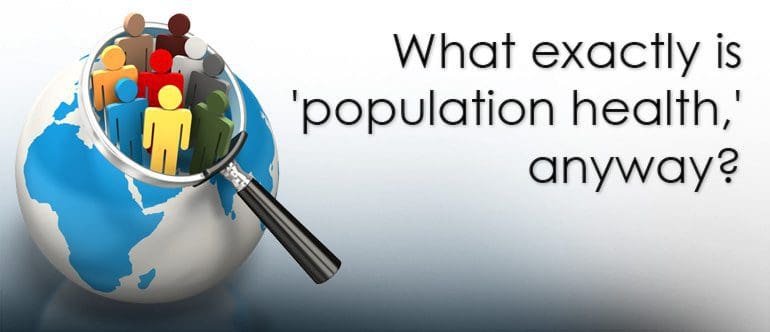Call us toll-free: 800-878-7828 — Monday - Friday — 8AM - 5PM EST

By Tom Sullivan for Healthcare IT News
As anyone who either attended HIMSS15 or followed the ensuing conversation can attest, population health is currently all the rage. While reporting from the show floor, in fact, it seemed just about every vendor, from all walks of life, was trumpeting “population health” in one form or another.
What has become eminently clear is that defining population health depends on whom you ask.
So I kept at it, posing the question to a hospital CEO and some of the technology vendors staking a claim to the expanding population health space.
Varying descriptions
St. Joseph Hospital in Nashua, N.H., embarked on the population health road to both control costs and ratchet up the percentage of revenue it brings in from alternative payment models.
“I take a fairly broad view of population health, more than just chronic disease management,” said St. Joseph’s CEO Richard Boehler, MD. “It’s the ability of a provider to effectively manage the healthcare needs of a defined group across the continuum of services either through direct provision of care or through structured relationships with other providers.”
Ideas about spanning the continuum and better care coordination were prevalent among the answers.
Caradigm senior vice president of global population health Brian Drozdowicz, in fact, said the whole point is “providing better quality care in a more efficient manner.”
Caradigm, which offers care coordination and analytics tools, is among the vendors selling technology to help hospitals manage that – as is Philips, with a range of home health monitoring products.
“Population health management is a coordinated effort to care for at-risk patient populations – such as those with chronic diseases and high care utilization rates – across the continuum to improve their outcomes and reduce costs,” said Linda Schertzer, senior product manager with Philips Home Monitoring. “Solutions need to expand across the health continuum, from healthy living, prevention, diagnosis, treatment, recovery and home care, to truly impact patients’ health at the individual and population levels.”
Voice and language technology specialist Nuance, meanwhile, takes the long view – as in life-long.
“My simple definition is the comprehensive care provided to an entire population from birth to death that uses and continuously improves best practice delivery of care to improve the current health and future wellbeing of that population,” said Tony Oliva, MD, Nuance’s national medical director.
Achieving any of the above will require some deft technology chops, to be certain. But the eventual payoff resides in early detection and prevention.
“Healthcare will transform from reactive and transactional to proactive and ongoing,” said Ron Razmi, MD, CEO of Acupera, which sells cloud-based population health management services. “The result will be better anticipation of issues and preventing them, and highly effective strategies to manage those with chronic illnesses.”
Common characteristics
The definitions are actually more similar than I expected upon leaving HIMSS15 and continuing to ask industry professionals since the show ended – even if those answering take distinct tacks, and employ different technologies, toward that goal.
A reduction sauce of these answers might look something like this: Population health means efficiently managing the health needs of a defined group’s entire lifespan by coordinating across the continuum – harnessing modern technologies to proactively spot, ideally prevent and, when need be, effectively treat and manage chronic illness, all while continuously improving best practices and standards of care.
Any kind of ubiquity for that practice, obviously, is a future state. And that hard part will be blazing the trail that takes us there.
